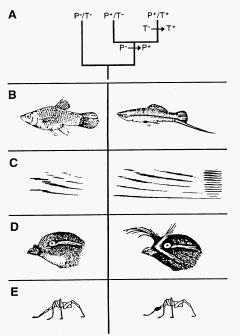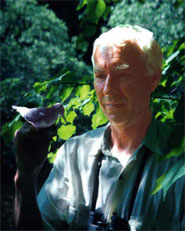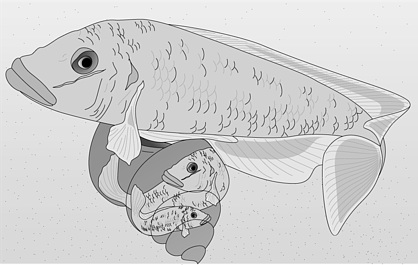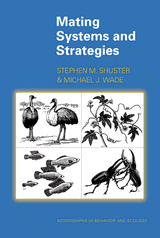Animal Behavior
Biology 342 Fall 08
Professor: Suzy Renn
Week 3 - Sept 16th
Mating Systems and Sex Role Behavior
MOODLE:
This one should be fun! Please post and comment on papers that describe
interesting, or unusual mating strategies. Stick to the scientific
research papers please.
I'd like to see some papers from week 1 reappear with more discussion:
---sailfin
mollies
---the heleconius butterfly,
---sexual cannibalism
---nonconceptive sexual behavior (this one might fit with Roughgarden
ideas as well)
Sorry, that we did not get as far as I anticipated last week. I had meant to offer a brief introduction to sexual selection. Chapter 8 in the text book gives a good overview, or likely you can find definitions in an intro bio text book.
I have assigned the 1994 review by Crews because it demonstrates the diversity of sex determining mechanisms and how these related to behavioral differences. It emphasizes that the mammalian XY system that we are used to is not universal. His paper does not discuss sexual selection per se, but I felt it was important to see the variations of "sex".
The Clutton-Brock review provides a modern summary of sexual selection from a fairly traditional point of view. He does not contradict basic sexual selection theory but he does point out some holes that exist and some new research that needs to be incorporated into the theory. This short review paper appeared in Science, and therefore is intended for a fairly general audience. It was written in reaction to a review by Joan Roughgarden that we will not read, but I supply one piece by her if you are curious.
The Anderson and Simmons review is very dense. It was published in
Trends in Ecology and Evolution (TREE) which is aimed at a hard core
evolutionary biolgoy audience. I suggest that you read Clutton-Brock
and the book chapter first.
READ:
Chapter 8 in Essential Animal Behavior by G. Scott
Crews D. (1994) Animal Sexuality. Scientific American v?:107-114.
Clutton-Brock T. (2008) Sexual Selection in Males and Females. Science 318:1182-1185.
Andersson M. & Simmons,
L.W. (2006) Sexual selection and mate choice. Trends in Ecology
and Evolution 21:296-302.
FOR MORE DETAIL
Ryan, M.J.
(1998) Sexual
Selection, Receiver Biases, and the Evolution of Sex Differences. Science,
281:1999-2003
(note: this one opens in acrobat only. It will
not open in prerview)

 For futher reading, I highly recommend the 1994 book by Anderson, Sexual
Selection. This book is considered to be the best reference in
the field and includes many examples that include animal behavior.
For futher reading, I highly recommend the 1994 book by Anderson, Sexual
Selection. This book is considered to be the best reference in
the field and includes many examples that include animal behavior.
For a different view read:
Roughgarden (2004) Evolution
and the Embodiment of Gender in THINKING SEX/THINKING GENDER
EXTRA:
Garcia, C. M. and
Ramirez E. (2005) Evidence that sensory traps can evolve into honest
signals. Nature 434:501-505.
Week 3 - Sept 18th
Mating Strategies
Males of many species come in alternate morphs. For example the image
here shows an African cichlid, Lamprologus callipterus. In this
species, males are either large "nest males" who collect shells
in which the female will lay her eggs, or very small "dwarf males" that
hide, hoping to sneak a mating with the female (for more detail see Taborsky,
2001).
Why is it that in other cases males choose and females compete?
What ecological and evolutionary forces create this situation and what
are the mechanisms that underlie it.
READ:
For today you will read two papers about the evolution of mating systems, one
in fish and one in birds. Try to identify the commonalities rather than getting
bogged down in the details. Despite being
separated by 25 years, these papers are fairly similar.
Orians,
G.H. (1969) On
the evoution of mating systems in birds and mammals. American Naturalist 103:589-603.
(note: this one opens in acrobat only. In Preview
you will not see page 1-6)
Gross, M.R. (1996) Alternative
reproductive strategies and tactics: diversity within sexes. TREE 11:92-98.
Eens, M. and Pinxten, R. (2001) Sex-role reversal in vertebrates: behavioural and endocrinological accounts. Behavioural Processes 51:135 – 147.
When sexual selection is "reversed" we observe a reversal in "sex-role" behavior. Given the changing views on sexual selection and the increased awareness of mate choice in males and competition among females, I predict that the study of "sex-role reversal" will be radically altered in the near future. But for now, this review by Eens and Pinxten stands as a good summary of the best studied model organisms to date. Combine what you read here with the Andersson and Simmons review from tuesday.
EXTRA:
Trivers, R.L. (1972) Parental
investment and sexual selction in Sexual
Selection and the Descent of man 1782-1971, B. Cambell, ed, pp.136-79.
Chicago: Aldine (also available in Foundations of
Animal Behavior).

This paper by Trivers is one of the most cited works in modern research on the evolution of reproductive behavior and strategies. However, you should be aware that there are researches who disagree with some of his views, arguing that it is possible to measure sexual selection directly rather than indirectly. The book Mating Systems and Strategies by Schuster and Wade (2003) provides an accessible explanation in chapter 3.
The original Bateman 1948 paper continues to be controversial and in fact stimulated a recent symposium "Bateman’s Principle: Is It Time for a Reevaluation? presented at the Annual Meeting of the Society for Integrative and Comparative Biology, 5–9 January 2004, at New Orleans, Louisiana. The publications are availabe in Volume 45 of the journal Integrative and Comparative Biology through the Reed Libray online.
After a Break:
SCIENTIFIC PROCESS:
Today we will look at a classic paper on modern scientific methods.
Consider how this differs from the way you were taught to write an
hypothesis and a null hypothesis. Using "strong inference" one
still uses statistical tests to test the null hypothesis. There is
not a statistical test that allows you to accept an hypothesis, statistical
tests still allow you to reject a null hypothesis.
Platt J.R. (1964) Strong
Inference. Science 146:347-353.
(note: this one opens in acrobat only. It will not open in prerview)